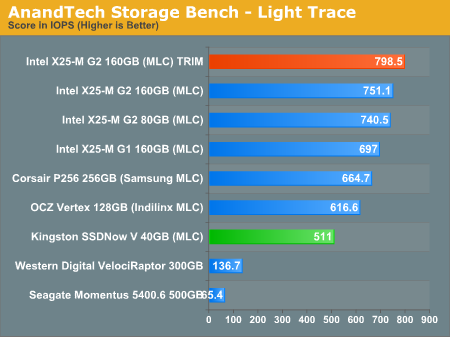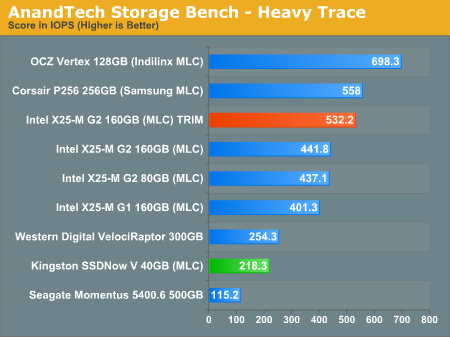The SSD Improv: Intel & Indilinx get TRIM, Kingston Brings Intel Down to $115
by Anand Lal Shimpi on November 17, 2009 7:00 PM EST- Posted in
- Storage
Introducing the AnandTech Storage Bench - Real World Performance Testing
Finding good, real world, storage benchmarks is next to impossible. The synthetic tests work up to a certain point but you need real world examples. Measuring performance in individual applications often ends up with charts like these where all of the drives perform identically. Benchmark suites like PCMark Vantage are the best we can do, but they are a bit too easy on these drives in my opinion and while representative of a real world environment, they aren’t necessarily representative of all real world environments.
Recently we’ve been able to get our hands on a piece of software that allows us to record all disk activity on a machine and then play it back on any other machine. The point is that we can now model a real world usage scenario without waiting for BAPCo or Futuremark to do it for us.
Our benchmarks debut here, today, and we’re starting with three. We haven’t had time to run all of the SSDs through this new suite so we’ll start with an abridged list.
The first in our new benchmark suite is a light usage case. The Windows 7 system is loaded with Firefox, Office 2007 and Adobe Reader among other applications. With Firefox we browse web pages like Facebook, AnandTech, Digg and other sites. Outlook is also running and we use it to check emails, create and send a message with a PDF attachment. Adobe Reader is used to view some PDFs. Excel 2007 is used to create a spreadsheet, graphs and save the document. The same goes for Word 2007. We open and step through a presentation in PowerPoint 2007 received as an email attachment before saving it to the desktop. Finally we watch a bit of a Firefly episode in Windows Media Player 11.
There’s some level of multitasking going on here but it’s not unreasonable by any means. Generally the application tasks proceed linearly, with the exception of things like web browsing which may happen in between one of the other tasks.
The recording is played back on all of our drives here today. Remember that we’re isolating disk performance, all we’re doing is playing back every single disk access that happened in that ~5 minute period of usage. The light trace is composed of 37,501 reads and 20,268 writes. Over 30% of the IOs are 4KB, 11% are 16KB, 22% are 32KB and approximately 13% are 64KB in size. Less than 30% of the operations are absolutely sequential in nature. Average queue depth is 6.09 IOs.
The performance results are reported in I/O Operations per Second (IOPS):

The hard drives set the minimum level of expectations here, the VelociRaptor only manages 137 IOPS. The fastest SSD is the X25-M G2 with the TRIM firmware installed at nearly 800 IOPS. The improvement over the older firmware is 6.25% thanks to the higher sequential write speed. The G2 is a bit faster than the G1 here, but what’s most interesting is how well the competing SSDs do.
Corsair’s P256 based on the Samsung RBX controller is very close to the performance of Intel’s X25-M G1 at 664 IOPS. It even outperforms the Indilinx MLC based OCZ Vertex by around 8%.
The Kingston 40GB drive is hampered by its small amount of free space. The actual benchmark takes up around 33GB of space, leaving very little breathing room for the baby SSD. That being said, the hopefully $85 bugger is nearly 4x the speed of a VelociRaptor.
If there’s a light usage case there’s bound to be a heavy one. In this test we have Microsoft Security Essentials running in the background with real time virus scanning enabled. We also perform a quick scan in the middle of the test. Firefox, Outlook, Excel, Word and Powerpoint are all used the same as they were in the light test. We add Photoshop CS4 to the mix, opening a bunch of 12MP images, editing them, then saving them as highly compressed JPGs for web publishing. Windows 7’s picture viewer is used to view a bunch of pictures on the hard drive. We use 7-zip to create and extract .7z archives. Downloading is also prominently featured in our heavy test; we download large files from the Internet during portions of the benchmark, as well as use uTorrent to grab a couple of torrents. Some of the applications in use are installed during the benchmark, Windows updates are also installed. Towards the end of the test we launch World of Warcraft, play for a few minutes, then delete the folder. This test also takes into account all of the disk accesses that happen while the OS is booting.
The benchmark is 22 minutes long and it consists of 128,895 read operations and 72,411 write operations. Roughly 44% of all IOs were sequential. Approximately 30% of all accesses were 4KB in size, 12% were 16KB in size, 14% were 32KB and 20% were 64KB. Average queue depth was 3.59.

While I appreciate that Intel improved sequential write speed a bit in the 160GB G2 drives, the heavy trace results show us that it’s not enough. The improvement to the 160GB G2 is tremendous, over 20%. But that only brings the 160GB G2 up to the performance of the Corsair P256 (Samsung RBX). The real winner here is the Indilinx based OCZ Vertex. At nearly 700 IOPS it has the right balance of random and sequential read/write speed for our heavy usage scenario. To quote from the Relapse:
“When I started writing this article I took a big step. I felt that Indilinx drives had reached the point that their performance was good enough to be considered an Intel alternative. I backed up my X25-M, pulled it out, and swapped in an OCZ Vertex drive - into my personal work system. I've been using it ever since and I must admit, I am happy. Indilinx has done it, these drives are fast, reliable (provided that you don't upgrade to the latest firmware without waiting a while) and are good enough.”
This is more than good enough, this is faster than Intel.
Unfortunately Intel has assured me that there’s no additional write speed left on the table for the X25-M G2. We’ll have to wait for the G3 next year to see that addressed.
Kingston’s very low sequential write speed hurts it the most here, the drive actually delivers performance lower than that of a VelociRaptor (although not by much). To be honest, this is a bit of an unfair test for the 40GB drive. It’s far too intense for what would ultimately be an apps/OS drive, but it does highlight the 40GB drive's weakpoints.
Our final test focuses on actual gameplay in four 3D games: World of Warcraft, Batman: Arkham Asylum, FarCry 2 and Risen, in that order. The games are launched and played, altogether for a total of just under 30 minutes. The benchmark measures game load time, level load time, disk accesses from save games and normal data streaming during gameplay.
The gaming trace is made up of 75,206 read operations and only 4,592 write operations. Only 20% of the accesses are 4KB in size, nearly 40% are 64KB and 20% are 32KB. A whopping 69% of the IOs are sequential, meaning this is predominantly a sequential read benchmark. The average queue depth is 7.76 IOs.

The gaming test is almost entirely reads and thus the Intel drives have no weaknesses. The G2s, G1s, TRIM or not, all perform about the same here. They’re about 10% faster than Samsung and 15% faster than Indilinx. Even the 40GB Kingston does just as well here.










162 Comments
View All Comments
Anand Lal Shimpi - Monday, October 26, 2009 - link
Thanks guys :)Take care,
Anand
jimhsu - Monday, October 26, 2009 - link
Since I've been wondering about the free space issue, will there be a test where a drive is benchmarked vs. the amount of free space available? My guess is that the graph will be an exponential decay with the "noticeable" regime at 20% free space. Anyone cares to do this (say, at 90%, 80% ... close to zero free space)?Crittias - Monday, October 26, 2009 - link
So, without TRIM, is there anything else G1 owners can do? Can I manually wipe the drive and reinstall my OS every few months? If so, should I?mataichi - Monday, October 26, 2009 - link
I have the G1 and in Anand's previous SSD Anthology article he tells how to get back to 100% performance using HDDERASE.http://www.anandtech.com/storage/showdoc.aspx?i=35...">http://www.anandtech.com/storage/showdoc.aspx?i=35...
This is total crap that Intel is not supporting the G1.
DanH - Monday, October 26, 2009 - link
Buy the G2, clone the G1 to it and sell the gen 1. Really. It is not a big loss of money to do it.lorax1284 - Tuesday, December 15, 2009 - link
Basically, you suggest we pass our problem on to someone else who is less informed. It's called "Ethics". Look into it.Just because Intel has none doesn't mean I'm going to abandon mine.
klil - Monday, October 26, 2009 - link
The only option you, a G1 owner, have to make your drive's performance back to ~100% is to do a full format of the drive. I'm pretty sure it would have to be done very frequently, each time you write 80/160GB of data to the drive... nothing else you can do, sorry =(Intel's wipe ultility (SSD Toolbox) only works with the G2 (for use with Windows XP/Vista) and TRIM only works with the G2 as well (for use with Windows 7-to replace the Toolbox)... =(
Zoomer - Monday, October 26, 2009 - link
One can always try the Indillinx tool, after making a full backup, of course. Heck, 80GB would be less than two blu-rays.klil - Monday, October 26, 2009 - link
Another great article by the one and only Anand Shimpi, king of SSDsSo, basically Intel made a very stupid move by only allowing SSD Toolbox AND TRIM on G2 drives. I would like to know if its due to architectural changes (perhaps?), maybe you know it but can't reveal it to anyone... if I weer you i would edit out the part when you say the G3 are coming next year... or else Intel will kill you, they just lost a custumer for the G2 (me)
But would it make sense for them to release the SATA 6 G3 drives next year if their on-board ICH10 and MCH P55 does not support it? Maybe the P57 and X68 will? Who knows?
I'll still be waiting for those Gulftowns... =D
Bakkone - Monday, October 26, 2009 - link
Don't think its that much of a secret that we will se a new generation next year. We need a version that uses Sata3 (6Gb).